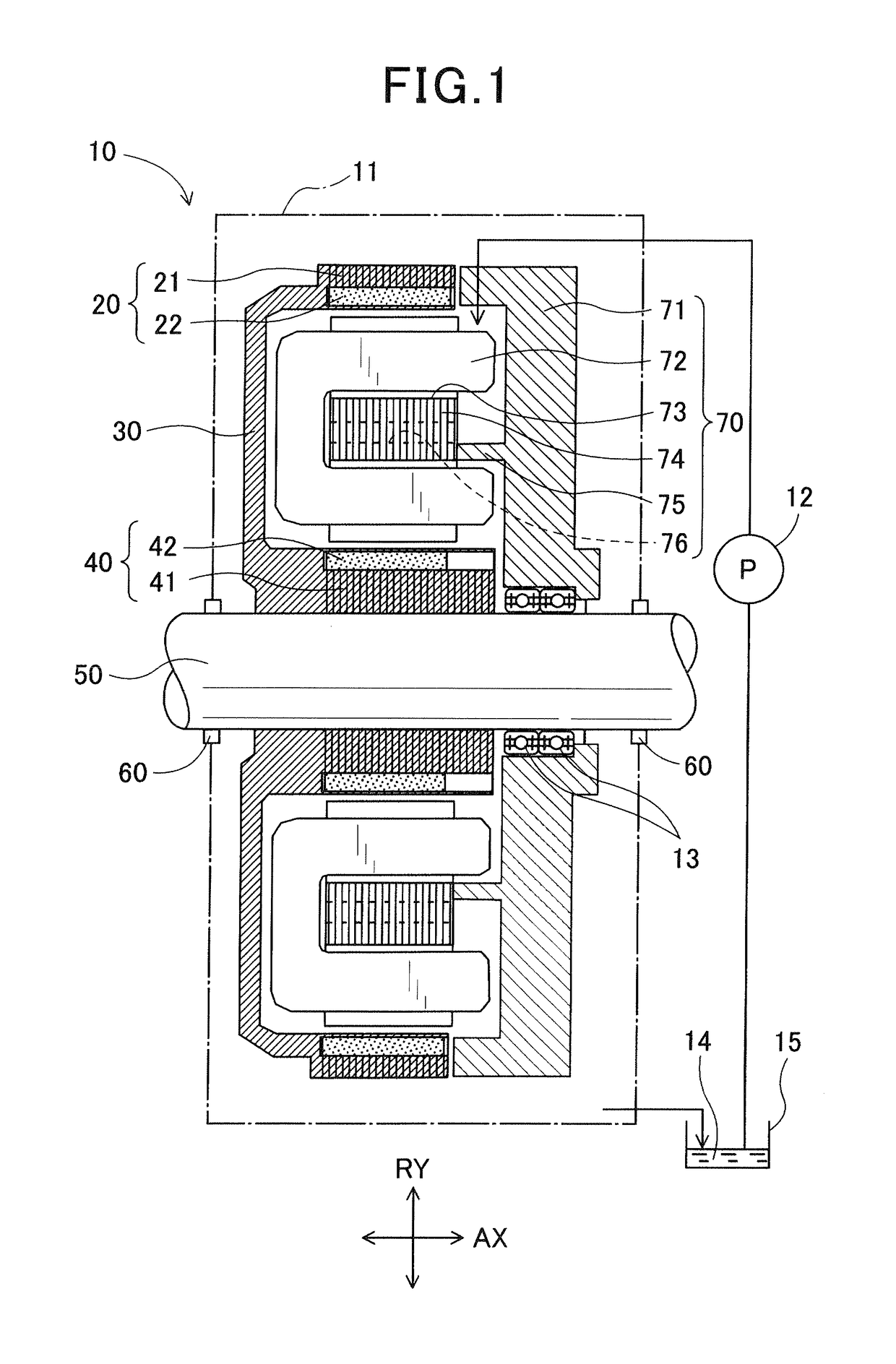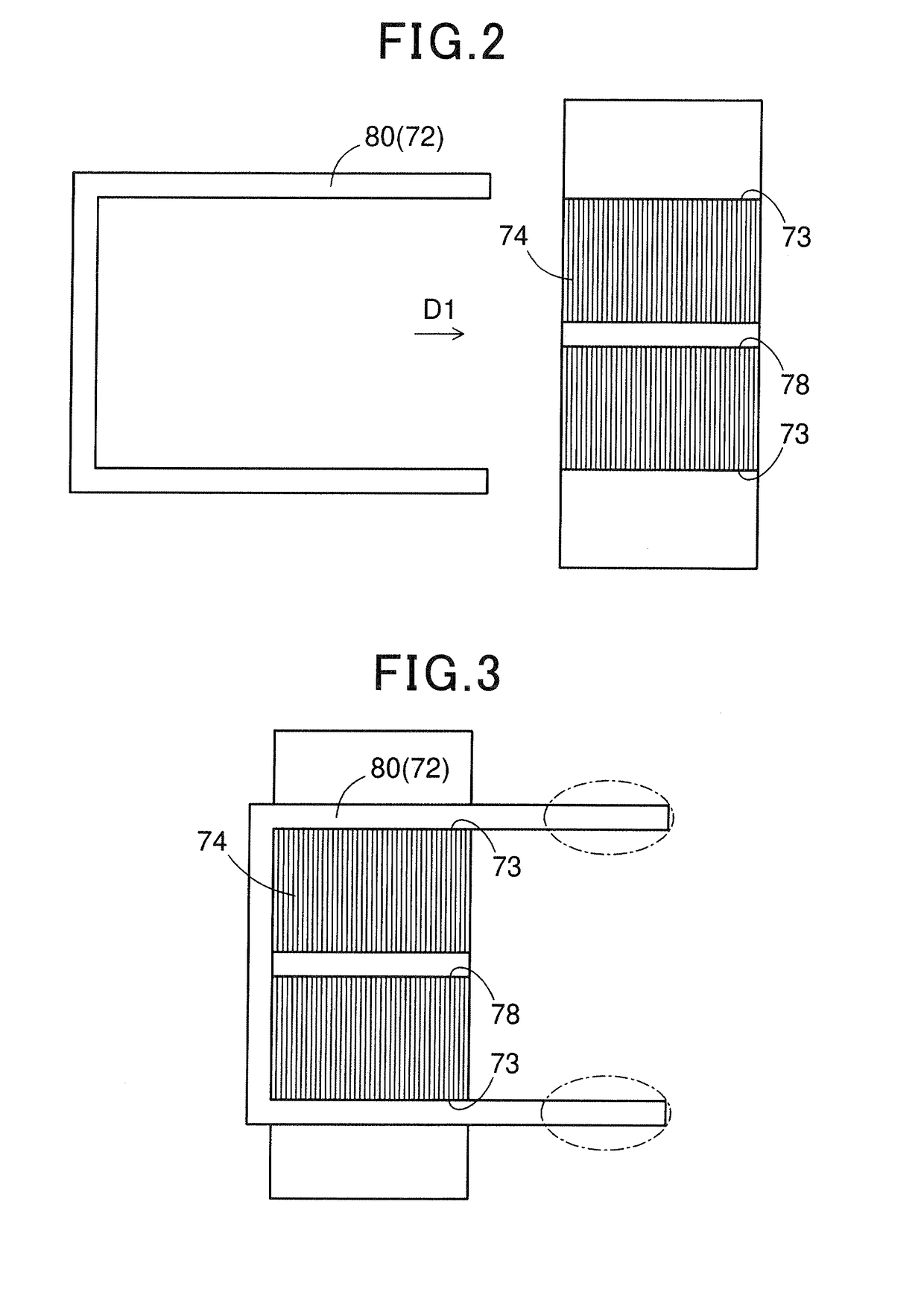Dual-rotor electric rotating machine
a technology of electric rotating machines and rotating shafts, which is applied in the direction of rotating magnets, synchronous machines with stationary armatures, cooling/ventilation arrangements, etc., can solve the problems of reducing affecting the operation affecting the efficiency of the machine, so as to achieve the effect of minimizing size, high space factor, and ensuring high performan
- Summary
- Abstract
- Description
- Claims
- Application Information
AI Technical Summary
Benefits of technology
Problems solved by technology
Method used
Image
Examples
first embodiment
[0035]FIG. 1 shows the overall configuration of a dual-rotor electric rotating machine 10 according to a first embodiment.
[0036]In the present embodiment, the electric rotating machine 10 is configured as a motor-generator that selectively functions either as an electric motor or as an electric generator.
[0037]As shown in FIG. 1, the electric rotating machine 10 includes a housing 11, a pump 12, fluid 14, a reservoir 15, a first rotor 20, a second rotor 40, a disc portion 30, a rotating shaft 50 and a stator 70.
[0038]The housing 11, which is depicted with one-dot chain lines in FIG. 1, receives therein the first rotor 20, the second rotor 40, the disc portion 30, the rotating shaft 50 and the stator 70.
[0039]It should be appreciated that the housing 11 may be formed of any suitable material into any suitable shape provided that it can receive the aforementioned components therein.
[0040]Moreover, the fluid 14, which is drawn up by the pump 12 from the reservoir 15, flows inside the h...
second embodiment
[0101]In the previous embodiment, the number of the magnets 22 arranged on the radially inner periphery of the first rotor 20 is equal to the number of the magnets 42 arranged on the radially outer periphery of the second rotor 40. Moreover, each of the magnets 22 of the first rotor 20 is radially aligned with a corresponding one of the magnets 42 of the second rotor 40. In other words, each of the magnets 42 of the first rotor 20 is not offset from the corresponding magnet 42 of the second rotor 40 in the circumferential direction of the stator core 74 (i.e., the left-right direction in FIG. 10).
[0102]In comparison, in the present embodiment, as shown in FIG. 14, each of the magnets 22 of the first rotor 20 is offset from a corresponding one of the magnets 42 of the second rotor 40 in the circumferential direction of the stator core 74 by a predetermined angle θ. In addition, the predetermined angle θ may be greater than or equal to 25° and less than or equal to 35°.
[0103]With the ...
third embodiment
[0104]In the previous embodiments, each of the magnets 22 of the first rotor 20 overlaps a corresponding one of the magnets 42 of the second rotor 40 in a radial direction of the stator core 74 (see FIGS. 10 and 14).
[0105]In comparison, in the present embodiment, some of the magnets 22 are omitted from the first rotor 20 as indicated with two-dot chain lines in FIG. 15; though not shown in the figure, some of the magnets 42 are omitted from the second rotor 40. Consequently, none of the magnets 22 of the first rotor 20 overlap any of the magnets 42 of the second rotor 40 in a radial direction of the stator core 74. That is, in the present embodiment, the magnets 22 of the first rotor 20 are arranged alternately with the magnets 42 of the second rotor 40 in the circumferential direction of the stator core 74 (i.e., the left-right direction in FIG. 15).
[0106]As a result, in the present embodiment, each of the magnets 22 of the first rotor 20 is radially aligned with a consequent magne...
PUM
 Login to View More
Login to View More Abstract
Description
Claims
Application Information
 Login to View More
Login to View More - R&D
- Intellectual Property
- Life Sciences
- Materials
- Tech Scout
- Unparalleled Data Quality
- Higher Quality Content
- 60% Fewer Hallucinations
Browse by: Latest US Patents, China's latest patents, Technical Efficacy Thesaurus, Application Domain, Technology Topic, Popular Technical Reports.
© 2025 PatSnap. All rights reserved.Legal|Privacy policy|Modern Slavery Act Transparency Statement|Sitemap|About US| Contact US: help@patsnap.com



